Princeton University
Visual Arts Program
VIS 217, C-i-r-c-u-l-a-t-i-o-n
Tuesdays, 1:30–4:20 pm
Spring 2023
The practice of graphic design relies on the existence of networks for distributing multiple copies of identical things. Students in this course will consider the ways in which a graphic design object’s characteristics are affected by its ability to be copied and shared, and by the environment in which it is intended to circulate. Through hands-on design projects, readings, and discussions, students will delve into different material forms of distribution — the printed newspaper, social network software, the community radio station, the PDF.
http://c-i-r-c-u-l-a-t-i-o-n.org
Print syllabus / Download readings
January 28, 2025
Who turns out the light?
Who turns out the light?
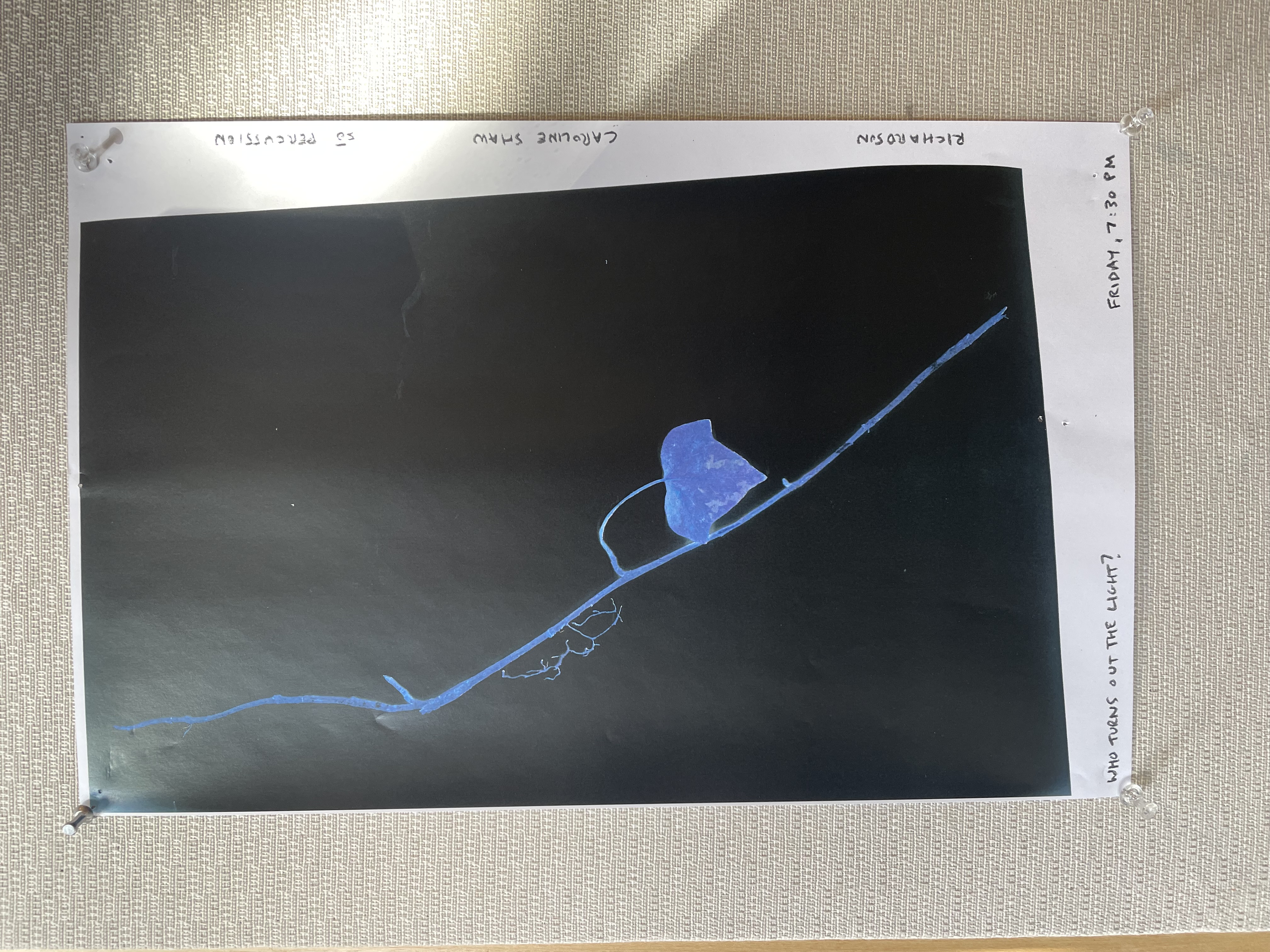
February 4, 2025
The Information
Readings
The-Information.pdf (James Gleick)
Resources
Designing-a-Book-Cover-for-Italo-Calvino.pdf (Interview with Peter Mendelsund)
Ada, Countess of Lovelace iBooks sample
A-Mathematical-Theory-of-Communication.pdf
Bobby C. Martin, Jr. and Abyssinian Baptist Church
Peter Mendelsund, Cover and What We See When We Read
Assignment
#1 The Information
The Information
Readings
The-Information.pdf (James Gleick)
Resources
Designing-a-Book-Cover-for-Italo-Calvino.pdf (Interview with Peter Mendelsund)
Ada, Countess of Lovelace iBooks sample
A-Mathematical-Theory-of-Communication.pdf
Bobby C. Martin, Jr. and Abyssinian Baptist Church
Peter Mendelsund, Cover and What We See When We Read
Assignment
#1 The Information
Popular science writer James Gleick recently published a book titled simply, The Information. Perhaps you’ve seen it? Maybe even read it, all 526 pages worth? I haven’t. But, I *was* instantly aware of it when it was published in March 2011 through book reviews like this one by Geoffrey Nunberg in The New York Times. You might notice that the review published March 18 in print is concluded by a correction added April 3 on the website:

Meanwhile, I caught glancing references to The Information in other magazines, on the radio, through websites, in conversation. The book’s subject matter, so far as I gleaned from these secondary sources, is information theory and includes the essentially-related subtopics of entropy, publication, computer networks, semantic chains, bits, encoding, and communication at large. Its constellation of references includes Ada Lovelace, Alan Turing’s universal computer, Kurt Gödel, Claude Shannon, Bell Labs, Norbert Wiener, cybernetics, MIT, logical recursion, and so on and so on.

All of this seemed way too close to my own interests; I was almost afraid to read it. (I’ve no idea if you can relate to this impulse, but I was worried that my thinking might be spoiled by reading someone else’s synthesis of this material.) It was as if a more accomplished thinker and writer had opened the most active corners of my brain, mined the pertinent subjects, and ghosted it into a comprehensive and cohesive commercially available non-fiction hardback.
Several close friends showed no such reticence and began reading it immediately on publication. I soon heard accounts of how wonderful the book is. They might drop a nugget, a chapter title, or just offer a generalized effusive blessing. I resolved to read it myself once it came out in paperback. This bought me some time and anyway, I hate the unwieldiness of trade hardcover books with that many pages. Surely the paperback would be a bit more manageable — I could carry it on the subway, take it on a trip, curl up with it in bed.
One friend in particular was becoming increasingly emphatic, insisting I must read the book now. In June, he scanned Chapter 14, “After the Flood (A Great Album of Babel),” made a PDF and emailed it to me. He suggested I read only this chapter now (it is around Wikipedia and the endgame of libraries in the face of the ultimate archive known as the internet), as a preview or trailer for the rest of the book. So I read it. How could I not after such an effort? It *was* fantastic and my anticipation for the whole book was further stoked by this recommendation.
By August that year, my brother-in-law toted the brick-of-a-book up on vacation to Vermont because he thought I’d enjoy it. Well, yes, I probably would, but not yet.
Continues in class . . .
A review on March 20 about The Information, James Gleick’s history of data organization, misstated the surname of the founder of cybernetics. He was Norbert Wiener, not Weiner.”I, however, read it on paper, complete with the error.

Meanwhile, I caught glancing references to The Information in other magazines, on the radio, through websites, in conversation. The book’s subject matter, so far as I gleaned from these secondary sources, is information theory and includes the essentially-related subtopics of entropy, publication, computer networks, semantic chains, bits, encoding, and communication at large. Its constellation of references includes Ada Lovelace, Alan Turing’s universal computer, Kurt Gödel, Claude Shannon, Bell Labs, Norbert Wiener, cybernetics, MIT, logical recursion, and so on and so on.

All of this seemed way too close to my own interests; I was almost afraid to read it. (I’ve no idea if you can relate to this impulse, but I was worried that my thinking might be spoiled by reading someone else’s synthesis of this material.) It was as if a more accomplished thinker and writer had opened the most active corners of my brain, mined the pertinent subjects, and ghosted it into a comprehensive and cohesive commercially available non-fiction hardback.
Several close friends showed no such reticence and began reading it immediately on publication. I soon heard accounts of how wonderful the book is. They might drop a nugget, a chapter title, or just offer a generalized effusive blessing. I resolved to read it myself once it came out in paperback. This bought me some time and anyway, I hate the unwieldiness of trade hardcover books with that many pages. Surely the paperback would be a bit more manageable — I could carry it on the subway, take it on a trip, curl up with it in bed.
One friend in particular was becoming increasingly emphatic, insisting I must read the book now. In June, he scanned Chapter 14, “After the Flood (A Great Album of Babel),” made a PDF and emailed it to me. He suggested I read only this chapter now (it is around Wikipedia and the endgame of libraries in the face of the ultimate archive known as the internet), as a preview or trailer for the rest of the book. So I read it. How could I not after such an effort? It *was* fantastic and my anticipation for the whole book was further stoked by this recommendation.
By August that year, my brother-in-law toted the brick-of-a-book up on vacation to Vermont because he thought I’d enjoy it. Well, yes, I probably would, but not yet.
Continues in class . . .
February 11, 2025
The Detroit Printing Co-op
Readings
The-Revolutionary-Potential-of-Design.pdf (Danielle Aubert)
Resources
All Printing Is Political: Fredy Perlman and the Detroit Printing Co-op
Inventory Press
Assignment
#1 The Information
The Detroit Printing Co-op
Readings
The-Revolutionary-Potential-of-Design.pdf (Danielle Aubert)
Resources
All Printing Is Political: Fredy Perlman and the Detroit Printing Co-op
Inventory Press
Assignment
#1 The Information
The Detroit Printing Co-op is the name of a recent book by Danielle Aubert, published by Inventory Press. It was also the name of a printing co-op in Detroit. The book’s online description offers a summary.
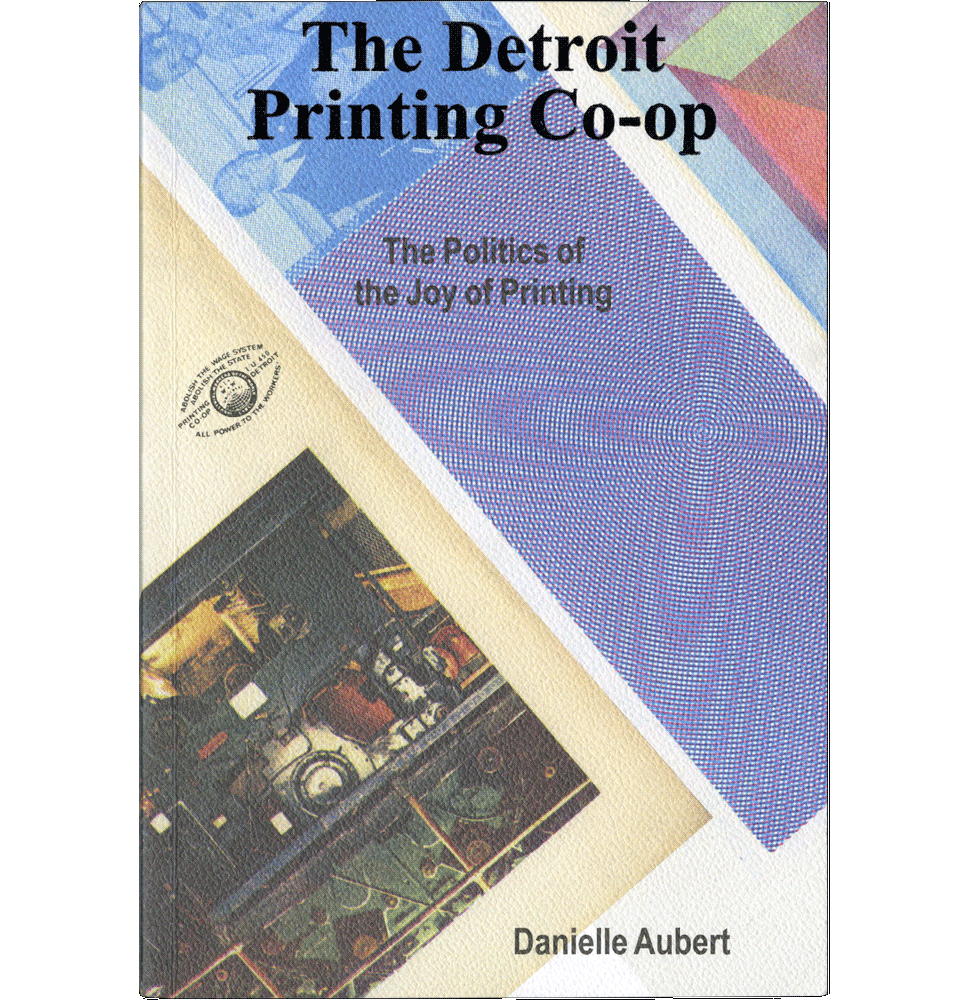
A recent exhibition, also assembled by Danielle, at 9338 Campau Gallery in Hamtramck, Michigan collected much of the original printed matter. Andrew Blauvelt writes about that exhibition and describes the Co-op's intentions in a post for the Walker Art Center website:

And, then here are a few of the materials printed in the Co-op. These range from books to posters to flyers to letters. They share a common commitment to form and message.



Continues in class . . .
In 1969, shortly after moving to Detroit, Lorraine and Fredy Perlman and a group of kindred spirits purchased a printing press from a defunct militant printer and the Detroit Printing Co-op was born. The Co-op would print the first English translation of Guy Debord’s Society of the Spectacle and journals like Radical America, formed by the Students for a Democratic Society; books such as The Political Thought of James Forman printed by the League of Revolutionary Black Workers; and the occasional broadsheet.
Fredy Perlman was not a printer or a designer by training, but was deeply engaged in ideas, issues, processes, and the materiality of printing. His exploration of overprinting, collage techniques, varied paper stocks, and other experiments underscores the pride of craft behind these calls to action and class consciousness.Danielle taught at Princeton for two years as a Princeton Arts Fellow in the Lewis Center. She initiated this class. So in a practical demonstration of c-i-r-c-u-l-a-t-i-o-n, we are happy to be joined by Danielle remotely from Detroit today. Here is the cover of her book:

A recent exhibition, also assembled by Danielle, at 9338 Campau Gallery in Hamtramck, Michigan collected much of the original printed matter. Andrew Blauvelt writes about that exhibition and describes the Co-op's intentions in a post for the Walker Art Center website:
The Detroit Printing Co-op existed from 1969 to 1985 in southwest Detroit, and as its founding manifesto decreed, offered printing facilities and equipment as “social property” to “provide access to all those individuals in the community who desire to express themselves (on a non-profit basis), with charges made only to maintain the print shop (rent, utilities, materials, maintenance of the machinery).”Printed matter from the Co-op was marked by this Union seal “bug” which makes concrete the printers’ intentions and demands:

And, then here are a few of the materials printed in the Co-op. These range from books to posters to flyers to letters. They share a common commitment to form and message.



Continues in class . . .
February 18, 2025
It feels different this time.
Readings
“It is Time for Reparations.” (Nikole Hannah-Jones)
Resources
Black Lives Matter
Black Lives Matter on Library Stack
@justiceforgeorgenyc
Champions Design
Black Lives Matter, The Brand
New York Times Magazine masthead
Exercise
Nuclear Disarmament
Extinction Rebellion
ACT UP
MUSE
Recycling
Black Power
Doomsday Clock
Gay Pride
Earth Day
It feels different this time.
Readings
“It is Time for Reparations.” (Nikole Hannah-Jones)
Resources
Black Lives Matter
Black Lives Matter on Library Stack
@justiceforgeorgenyc
Champions Design
Black Lives Matter, The Brand
New York Times Magazine masthead
Exercise
Nuclear Disarmament
Extinction Rebellion
ACT UP
MUSE
Recycling
Black Power
Doomsday Clock
Gay Pride
Earth Day
And so

Here (above) is a view from above.

Which, with its hand-painted and traffic-yellow-on-black type, by New York designer Bobby Martin immediately conjured the Brooklyn mural I had just seen. And it made me think more about the way that this urgent message was being carried, circulated, by a precise, robust, and defined graphic language. In the seven years that the movement has moved from a hashtag to global rally, this graphic language has also *evolved,* producing new forms and signatures as it has moved from place to place, circling the world, and penetrating the consciousness of millions, no billions, of people. Let's get back to the article—I will be reading about half of this today in class and you will be able to read the rest online.

Continues in class . . .
It feels different this time.In the June 28, 2020 issue of The New York Times Magazine Nikole Hannah-Jones continues.
Black Americans protesting the violation of their rights are a defining tradition of this country. In the last century, there have been hundreds of uprisings in black communities in response to white violence. Some have produced substantive change. After the assassination of the Rev. Dr. Martin Luther King Jr. in 1968, uprisings in more than 100 cities broke the final congressional deadlock over whether it should be illegal to deny people housing simply because they descended from people who had been enslaved. The Fair Housing Act, which prohibits housing discrimination on the basis of race, gender and religion, among other categories, seemed destined to die in Congress as white Southerners were joined by many of their Northern counterparts who knew housing segregation was central to how Jim Crow was accomplished in the North. But just seven days after King’s death, President Lyndon B. Johnson signed the act into law from the smoldering capital, which was still under protection from the National Guard.This mural appeared on Fulton Street in the Bedford-Stuyvesant neighborhood of Brooklyn barely two weeks before the article was published. I took my then 14-year-old daughter before it was finished and it was deeply moving.

Here (above) is a view from above.
Most of the time these uprisings have produced hand-wringing and consternation but few necessary structural changes. After black uprisings swept the nation in the mid-1960s, Johnson created the Kerner Commission to examine their causes, and the report it issued in 1968 recommended a national effort to dismantle segregation and structural racism across American institutions. It was shelved by the president, like so many similar reports, and instead white Americans voted in a “law and order” president, Richard Nixon. The following decades brought increased police militarization, law-enforcement spending and mass incarceration of black Americans.
The changes we’re seeing today in some ways seem shockingly swift, and in other ways rage-inducingly slow. After years of black-led activism, protest and organizing, the weeks of protests since George Floyd’s killing have moved lawmakers to ban chokeholds by police officers, consider stripping law enforcement of the qualified immunity that has made it almost impossible to hold responsible officers who kill, and discuss moving significant parts of ballooning police budgets into funding for social services. Black Lives Matter, the group founded in 2013 by three black women, Patrisse Khan-Cullors, Alicia Garza and Opal Tometi, after the acquittal of Trayvon Martin’s killer, saw its support among American voters rise almost as much in the two weeks after Floyd’s killing than in the last two years. According to polling by Civiqs, more than 50 percent of registered voters now say they support the movement.“It is Time for Reparations.” That’s the clear, urgent article title when it appeared as the cover story with the following graphic:

Which, with its hand-painted and traffic-yellow-on-black type, by New York designer Bobby Martin immediately conjured the Brooklyn mural I had just seen. And it made me think more about the way that this urgent message was being carried, circulated, by a precise, robust, and defined graphic language. In the seven years that the movement has moved from a hashtag to global rally, this graphic language has also *evolved,* producing new forms and signatures as it has moved from place to place, circling the world, and penetrating the consciousness of millions, no billions, of people. Let's get back to the article—I will be reading about half of this today in class and you will be able to read the rest online.
The cascading effect of these protests has been something to behold. The commissioner of the N.F.L., which blackballed Colin Kaepernick for daring to respectfully protest police brutality, announced that the N.F.L. had, in fact, been wrong and that black lives actually do matter. (Kaepernick, on the other hand, still has no job.) HBO Max announced that it would temporarily pull from its roster the Lost Cause propaganda film “Gone With the Wind” — which in classically American fashion holds the spot as the highest-grossing feature film of all time. NASCAR came to the sudden realization that its decades-long permissiveness toward fans’ waving the battle flag of a traitorous would-be nation that fought to preserve the right to traffic black people was, in fact, contrary to its “commitment to providing a welcoming and inclusive environment for all fans, our competitors and our industry.” Bubba Wallace, the only full-time black driver at the sport’s top level, who had called on NASCAR to make the move, drove victory laps in an all-black stock car emblazoned with the words “#BLACKLIVESMATTER.”The resulting image is striking—literal circulation (and at full speed!) of the graphic hashtag as Bubba Wallace loops around the Martinsville speedway’s oval track.

Continues in class . . .
February 25, 2025
“We have no art, we do everything as well as we can.”
Reading
Lift and separate : graphic design and the quote vernacular unquote (editor Barbara Glauber)
Resources
We Have No Art
Power Up: The Work of Sister Corita with Barbara Glauber
the-copy.com
Assignment
#2 We have no art ...
“We have no art, we do everything as well as we can.”
Reading
Lift and separate : graphic design and the quote vernacular unquote (editor Barbara Glauber)
Resources
We Have No Art
Power Up: The Work of Sister Corita with Barbara Glauber
the-copy.com
Assignment
#2 We have no art ...
It seems to be a Balinese saying which Sister Corita Kent borrowed to describe what she was up to with her art classes at Immaculate Heart College for about 30 years:

Corita Kent was also already the subject of a 1967 documentary by Baylis Glascock, ”We Have No Art.” This film catches Kent at her lucid, modest, powerful best in the act of teaching. We are going to watch some choice excerpts from a 30-minute excerpt posted online.
Corita Kent worked most substantially in prints, typically roughly assembled silkscreens. Her source material was found close by, including the neighborhood Safeway supermarket where for example she sourced the colored dots from a bag of Wonder Bread to make this transcendent print, Wonderbread (1968):

These were rough and ready prints, assembled from materials found close at hand. They were also excuses to work together, and to learn as a group. This picture captures something of that spirit:

Her and her students’ prints were vehicles for a particular flavor of spiritual messages which mixed a benevolent Catholic mysticism with reaching out to the secular world in all of its complexities. She described this medium in particular in how and what she hoped to accomplish:
As sometimes happens in such a comprehensive book project, Barbara became deeply involved with its subject matter. This is hardly surprising given the amount of time a book project like this takes. From the material, Barbara devised a talk delivered at Cooper Union in New York. We will watch that in class.
Continues in class . . .
We have no art, we do everything as well as we can.Starting around 1938, Corita Kent lived in the community and taught at the private religious and art school in Los Angeles. Her classes continued until around 1968, by which time they attracted avante-garde artists and social activists from around the world including Charles and Ray Eames, Buckminster Fuller, John Cage, Alfred Hitchcock, and Saul Bass. By the time she left the College, she had appeared on the cover of Newsweek magazine:

Corita Kent was also already the subject of a 1967 documentary by Baylis Glascock, ”We Have No Art.” This film catches Kent at her lucid, modest, powerful best in the act of teaching. We are going to watch some choice excerpts from a 30-minute excerpt posted online.
Corita Kent worked most substantially in prints, typically roughly assembled silkscreens. Her source material was found close by, including the neighborhood Safeway supermarket where for example she sourced the colored dots from a bag of Wonder Bread to make this transcendent print, Wonderbread (1968):

These were rough and ready prints, assembled from materials found close at hand. They were also excuses to work together, and to learn as a group. This picture captures something of that spirit:

Her and her students’ prints were vehicles for a particular flavor of spiritual messages which mixed a benevolent Catholic mysticism with reaching out to the secular world in all of its complexities. She described this medium in particular in how and what she hoped to accomplish:
[printimaking] enables me to produce a quantity of original art for those who cannot afford to purchase high-priced art. … The distribution of these prints to everyday places of work pleases me, and I hope they will give people a lift.Corita Kent's work has been widely shown since. In the last few years there are at least two exhibitions which I would like you to have a look at. “Corita Kent and the Language of Pop” was initiated at the Harvard Art Museum in 2016 and tracks parallel streams in Kent's work and contemporary art of the time. “Someday is Now: The Art of Corita Kent” originated by the Frances Young Tang Teaching Museum and Art Gallery at Skidmore College looks like it was especially strong. That exhibition also produced an exceptional publication designed by Barbara Glauber, an independent graphic designer, writer, and teacher in New York.
As sometimes happens in such a comprehensive book project, Barbara became deeply involved with its subject matter. This is hardly surprising given the amount of time a book project like this takes. From the material, Barbara devised a talk delivered at Cooper Union in New York. We will watch that in class.
Continues in class . . .
March 4, 2025
A Happy Octopus
Readings
A-Happy-Octopus.pdf (Phyils and Philip Morrison)
Resources
Powers of Ten
Powers of Ten (A Rough Sketch for a Proposed Film)
Visitor
Chia Amisola
Assignment
#2 We have no art ...
A Happy Octopus
Readings
A-Happy-Octopus.pdf (Phyils and Philip Morrison)
Resources
Powers of Ten
Powers of Ten (A Rough Sketch for a Proposed Film)
Visitor
Chia Amisola
Assignment
#2 We have no art ...
The setting of any design, its wide context, lies around and underneath it; successful designers must know more than the work shows.This is Phylis and Philip Morrison writing about the work of Charles and Ray Eames. They should know, as the Morrisons collaborated with the Eames Office on a series of projects which married a deep understanding of scientific principles with inventive design to communicate complicated concepts to broad public audiences. Perhaps their best-known project together was the film Powers of Ten, which maybe you watched in elementary school. I did. But they also worked together on exhibition projects, curriculum projects, and other short films.
The Eames always knew more than was revealed in any one of their design projects. For example, when commissioned to design the National Fisheries Center and Aquarium, an expansive exhibition project on the Mall in Washington D.C, they set out to learn as much as possible about the subject including hosting a half-pint octopus in a tank in the office:
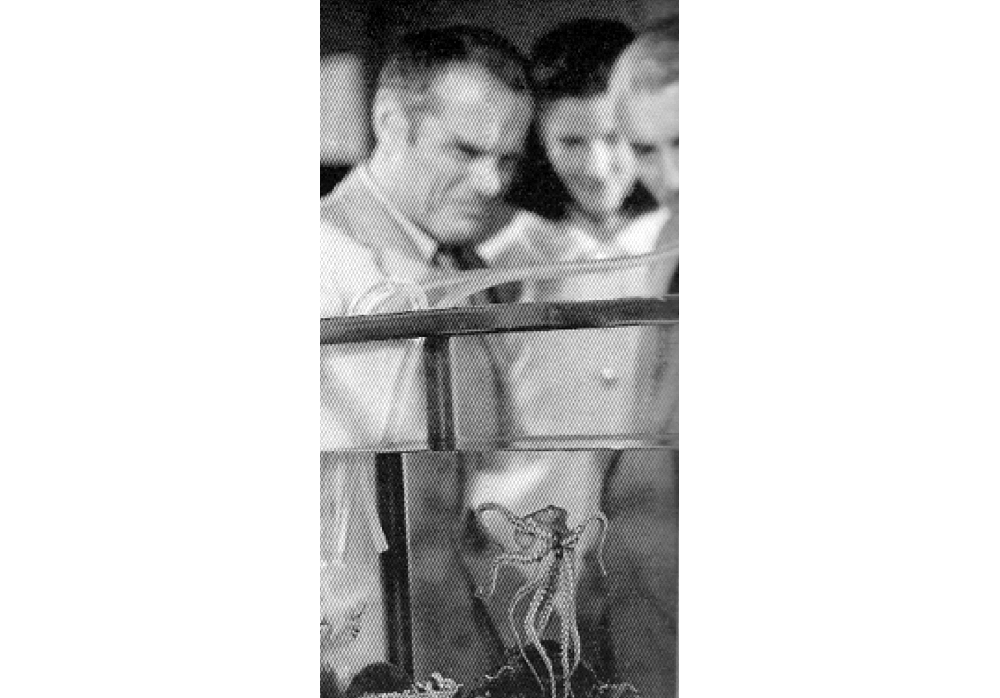
They treated the obligation so seriously, that this octopus became the longest-lived member of the species in captivity and would magically (it wasn’t really magic, but must have felt like it) change colors when staff members entered the room. If you have never seen an octopus do this, then you must. Here is a short video. You may not believe your eyes, but you should.
Charles and Ray met at Cranbrook Academy of Art in 1940. He was trained as an architect and she was a painter. They started to work together immediately and soon moved to Los Angeles, setting up a small design and research practice from their apartment. Their reputation grew and they accumulated employees and a vast design workshop in a disused industrial space at 901 Washington Avenue in Venice Beach. The Eames Office employed designers of all stripes including architects, industrial, and graphic designers, but also editors, producers, and model makers.
The Eames’ design approach has often been described as playful. And that is fair enough. That play was also carefully staged and, I imagine, this loose approach is what kept the work so inventive for so many years. Here is a publicity portrait of Charles and Ray where it seems they have been pinned by the octopus-like metal bases of a chair they had (at the time) recently designed for Herman Miller:

You can see in this making-of photograph how the final image was made. It simply looks loose and certainly fun. As much play as it is calculated production. I’ve seen this image in exhibitions of their work but I don’t know how or if it was used when it was made. But that hardly matters.

Continues in class . . .
March 18, 2025
A Happy Octopus
Readings
A-Happy-Octopus.pdf (Phyils and Philip Morrison)
Resources
Powers of Ten
Powers of Ten (A Rough Sketch for a Proposed Film)
Visitor
Chia Amisola
Assignment
#2 We have no art ...
A Happy Octopus
Readings
A-Happy-Octopus.pdf (Phyils and Philip Morrison)
Resources
Powers of Ten
Powers of Ten (A Rough Sketch for a Proposed Film)
Visitor
Chia Amisola
Assignment
#2 We have no art ...
The setting of any design, its wide context, lies around and underneath it; successful designers must know more than the work shows.This is Phylis and Philip Morrison writing about the work of Charles and Ray Eames. They should know, as the Morrisons collaborated with the Eames Office on a series of projects which married a deep understanding of scientific principles with inventive design to communicate complicated concepts to broad public audiences. Perhaps their best-known project together was the film Powers of Ten, which maybe you watched in elementary school. I did. But they also worked together on exhibition projects, curriculum projects, and other short films.
The Eames always knew more than was revealed in any one of their design projects. For example, when commissioned to design the National Fisheries Center and Aquarium, an expansive exhibition project on the Mall in Washington D.C, they set out to learn as much as possible about the subject including hosting a half-pint octopus in a tank in the office:

They treated the obligation so seriously, that this octopus became the longest-lived member of the species in captivity and would magically (it wasn’t really magic, but must have felt like it) change colors when staff members entered the room. If you have never seen an octopus do this, then you must. Here is a short video. You may not believe your eyes, but you should.
Charles and Ray met at Cranbrook Academy of Art in 1940. He was trained as an architect and she was a painter. They started to work together immediately and soon moved to Los Angeles, setting up a small design and research practice from their apartment. Their reputation grew and they accumulated employees and a vast design workshop in a disused industrial space at 901 Washington Avenue in Venice Beach. The Eames Office employed designers of all stripes including architects, industrial, and graphic designers, but also editors, producers, and model makers.
The Eames’ design approach has often been described as playful. And that is fair enough. That play was also carefully staged and, I imagine, this loose approach is what kept the work so inventive for so many years. Here is a publicity portrait of Charles and Ray where it seems they have been pinned by the octopus-like metal bases of a chair they had (at the time) recently designed for Herman Miller:

You can see in this making-of photograph how the final image was made. It simply looks loose and certainly fun. As much play as it is calculated production. I’ve seen this image in exhibitions of their work but I don’t know how or if it was used when it was made. But that hardly matters.

Continues in class . . .
March 25, 2025
Escape Velocity, or Interstellar Graphic Design
Readings
Pioneer-Plaque.pdf (Linda Salzman Sagan)
A-Million-Random-Digits.pdf (David Reinfurt)
Resources
NASA’s ‘Worm’ Logo Will Return to Space
Pioneer 10 plaque kickstarter
Pioneer Plaque (replica)
Pedestrian 24: A Space to Think
Studio Lab Training
Assignment
#3 The Pioneer Plaque
Escape Velocity, or Interstellar Graphic Design
Readings
Pioneer-Plaque.pdf (Linda Salzman Sagan)
A-Million-Random-Digits.pdf (David Reinfurt)
Resources
NASA’s ‘Worm’ Logo Will Return to Space
Pioneer 10 plaque kickstarter
Pioneer Plaque (replica)
Pedestrian 24: A Space to Think
Studio Lab Training
Assignment
#3 The Pioneer Plaque
Pioneer 10 is (perhaps, was?) a space probe launched by NASA in 1972 pointed towards Jupiter. The first part of its mission was to photograph the surface from space and study its immediate environment, the asteroid belt, the solar wind, and cosmic rays. On successfully completing this first part of its mission, Pioneer 10 used its orbit around the giant planet to slingshot beyond it, becoming the first human-made object to achieve the escape velocity required to leave the Solar System.
Radio communications were lost January 23, 2003 when electric power for its transmitter stopped. The probe was then nearly 12 billion kilometers from Earth. It must be further now. Here’s an artist’s impression.

Pioneer 10 had another, slightly below-the-radar, mission which involved a single piece of precious cargo—one 6 × 9 inch gold-anodized aluminum plaque bolted onto the frame of the satellite. The plaque was the work of Carl Sagan, a Cornell astrophysicist, Linda Salzman Sagan, an artist, and Frank Drake, an astronomer who later instigated the Arecibo message.
The original idea for the plaque came from Eric Burgess, a British journalist visiting the Jet Propulsion Laboratory in Pasadena, California. After being briefed on the mission plan for Pioneer 10, he reasoned that if NASA was going to attempt to launch the first human-made object out of our solar system, then it was possible that the probe might eventually be found somewhere else, and perhaps by extraterrestrial life forms. He dreamed up a cosmic message-in-a-bottle which would carry fundamental information about humans on Earth for the plaque’s extra-solar recipients.
Sagan was already working around and lecturing on alien communication, and he was invited to head up the effort. He was relatively young, charismatic, and had an exceptional ability to communicate complex astrophysical ideas in a direct fashion.
He went on to co-write and narrate a multi-part public television series, Cosmos, which made a big impression on me in my youth. He is magnetic onscreen, portraying a cocktail of wonder and skepticism that he would later insist was the key to doing good science; if you have not seen it, you really ought to. Here he is unpacking the 4th dimension.
The Pioneer 10 plaque is a densely coded graphic object, consisting of at four primary zones of information. At the top to the left, is a drawing which conveys the transition of a Hydrogen atom. The time and distance implied provides a standard unit which becomes a key for reading measures in the other graphics. Below that is a misshapen asterisk which conveys where in the universe this plaque originated by identifying Earth's coordinates using radio pulsar distances. To the right of that is a drawing of two humans which is not anatomically correct. And along the bottom is diagram of our solar system showing the path on which the satellite left. It is almost impossibly dense, and perhaps that makes sense given its ambitions. This first piece of interstellar graphic design is likely somewhere at least 7.6 billion miles away by now.
Here is Carl Sagan around 1972 holding the completed Pioneer 10 plaque:
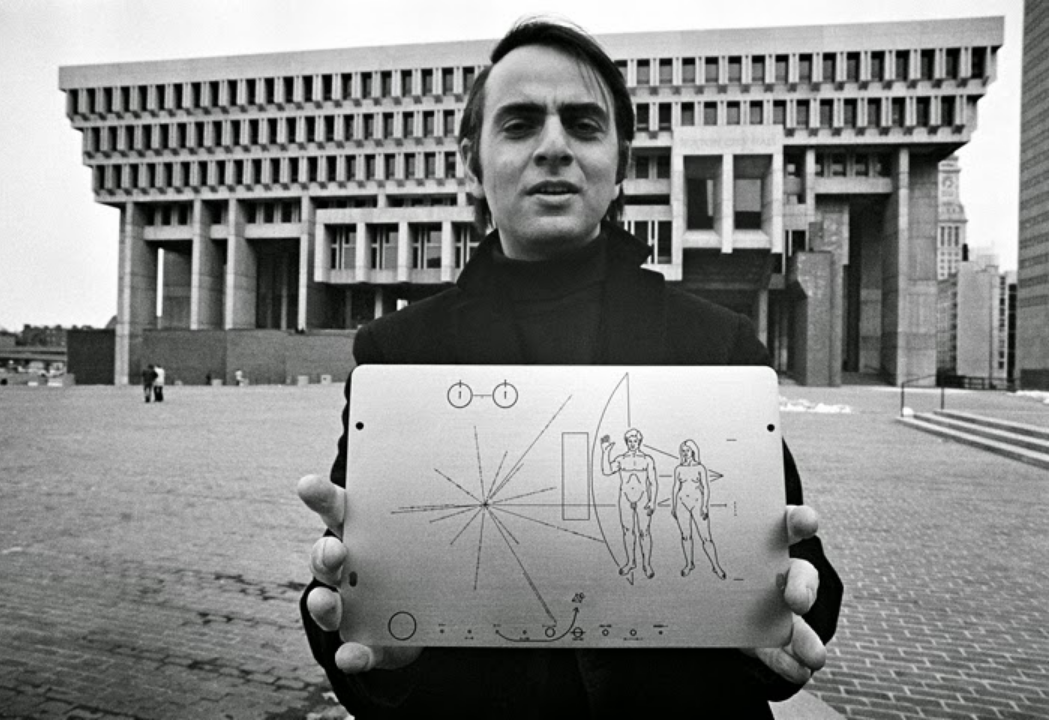
Continues in class . . .
Radio communications were lost January 23, 2003 when electric power for its transmitter stopped. The probe was then nearly 12 billion kilometers from Earth. It must be further now. Here’s an artist’s impression.

Pioneer 10 had another, slightly below-the-radar, mission which involved a single piece of precious cargo—one 6 × 9 inch gold-anodized aluminum plaque bolted onto the frame of the satellite. The plaque was the work of Carl Sagan, a Cornell astrophysicist, Linda Salzman Sagan, an artist, and Frank Drake, an astronomer who later instigated the Arecibo message.
The original idea for the plaque came from Eric Burgess, a British journalist visiting the Jet Propulsion Laboratory in Pasadena, California. After being briefed on the mission plan for Pioneer 10, he reasoned that if NASA was going to attempt to launch the first human-made object out of our solar system, then it was possible that the probe might eventually be found somewhere else, and perhaps by extraterrestrial life forms. He dreamed up a cosmic message-in-a-bottle which would carry fundamental information about humans on Earth for the plaque’s extra-solar recipients.
Sagan was already working around and lecturing on alien communication, and he was invited to head up the effort. He was relatively young, charismatic, and had an exceptional ability to communicate complex astrophysical ideas in a direct fashion.
He went on to co-write and narrate a multi-part public television series, Cosmos, which made a big impression on me in my youth. He is magnetic onscreen, portraying a cocktail of wonder and skepticism that he would later insist was the key to doing good science; if you have not seen it, you really ought to. Here he is unpacking the 4th dimension.
The Pioneer 10 plaque is a densely coded graphic object, consisting of at four primary zones of information. At the top to the left, is a drawing which conveys the transition of a Hydrogen atom. The time and distance implied provides a standard unit which becomes a key for reading measures in the other graphics. Below that is a misshapen asterisk which conveys where in the universe this plaque originated by identifying Earth's coordinates using radio pulsar distances. To the right of that is a drawing of two humans which is not anatomically correct. And along the bottom is diagram of our solar system showing the path on which the satellite left. It is almost impossibly dense, and perhaps that makes sense given its ambitions. This first piece of interstellar graphic design is likely somewhere at least 7.6 billion miles away by now.
Here is Carl Sagan around 1972 holding the completed Pioneer 10 plaque:

Continues in class . . .
April 1, 2025
Escape Velocity, or Interstellar Graphic Design
Readings
Pioneer-Plaque.pdf (Linda Salzman Sagan)
A-Million-Random-Digits.pdf (David Reinfurt)
Resources
NASA’s ‘Worm’ Logo Will Return to Space
Pioneer 10 plaque kickstarter
Pioneer Plaque (replica)
Pedestrian 24: A Space to Think
Studio Lab Training
Assignment
#3 The Pioneer Plaque
Escape Velocity, or Interstellar Graphic Design
Readings
Pioneer-Plaque.pdf (Linda Salzman Sagan)
A-Million-Random-Digits.pdf (David Reinfurt)
Resources
NASA’s ‘Worm’ Logo Will Return to Space
Pioneer 10 plaque kickstarter
Pioneer Plaque (replica)
Pedestrian 24: A Space to Think
Studio Lab Training
Assignment
#3 The Pioneer Plaque
Pioneer 10 is (perhaps, was?) a space probe launched by NASA in 1972 pointed towards Jupiter. The first part of its mission was to photograph the surface from space and study its immediate environment, the asteroid belt, the solar wind, and cosmic rays. On successfully completing this first part of its mission, Pioneer 10 used its orbit around the giant planet to slingshot beyond it, becoming the first human-made object to achieve the escape velocity required to leave the Solar System.
Radio communications were lost January 23, 2003 when electric power for its transmitter stopped. The probe was then nearly 12 billion kilometers from Earth. It must be further now. Here’s an artist’s impression.

Pioneer 10 had another, slightly below-the-radar, mission which involved a single piece of precious cargo—one 6 × 9 inch gold-anodized aluminum plaque bolted onto the frame of the satellite. The plaque was the work of Carl Sagan, a Cornell astrophysicist, Linda Salzman Sagan, an artist, and Frank Drake, an astronomer who later instigated the Arecibo message.
The original idea for the plaque came from Eric Burgess, a British journalist visiting the Jet Propulsion Laboratory in Pasadena, California. After being briefed on the mission plan for Pioneer 10, he reasoned that if NASA was going to attempt to launch the first human-made object out of our solar system, then it was possible that the probe might eventually be found somewhere else, and perhaps by extraterrestrial life forms. He dreamed up a cosmic message-in-a-bottle which would carry fundamental information about humans on Earth for the plaque’s extra-solar recipients.
Sagan was already working around and lecturing on alien communication, and he was invited to head up the effort. He was relatively young, charismatic, and had an exceptional ability to communicate complex astrophysical ideas in a direct fashion.
He went on to co-write and narrate a multi-part public television series, Cosmos, which made a big impression on me in my youth. He is magnetic onscreen, portraying a cocktail of wonder and skepticism that he would later insist was the key to doing good science; if you have not seen it, you really ought to. Here he is unpacking the 4th dimension.
The Pioneer 10 plaque is a densely coded graphic object, consisting of at four primary zones of information. At the top to the left, is a drawing which conveys the transition of a Hydrogen atom. The time and distance implied provides a standard unit which becomes a key for reading measures in the other graphics. Below that is a misshapen asterisk which conveys where in the universe this plaque originated by identifying Earth's coordinates using radio pulsar distances. To the right of that is a drawing of two humans which is not anatomically correct. And along the bottom is diagram of our solar system showing the path on which the satellite left. It is almost impossibly dense, and perhaps that makes sense given its ambitions. This first piece of interstellar graphic design is likely somewhere at least 7.6 billion miles away by now.
Here is Carl Sagan around 1972 holding the completed Pioneer 10 plaque:

Continues in class . . .
Radio communications were lost January 23, 2003 when electric power for its transmitter stopped. The probe was then nearly 12 billion kilometers from Earth. It must be further now. Here’s an artist’s impression.

Pioneer 10 had another, slightly below-the-radar, mission which involved a single piece of precious cargo—one 6 × 9 inch gold-anodized aluminum plaque bolted onto the frame of the satellite. The plaque was the work of Carl Sagan, a Cornell astrophysicist, Linda Salzman Sagan, an artist, and Frank Drake, an astronomer who later instigated the Arecibo message.
The original idea for the plaque came from Eric Burgess, a British journalist visiting the Jet Propulsion Laboratory in Pasadena, California. After being briefed on the mission plan for Pioneer 10, he reasoned that if NASA was going to attempt to launch the first human-made object out of our solar system, then it was possible that the probe might eventually be found somewhere else, and perhaps by extraterrestrial life forms. He dreamed up a cosmic message-in-a-bottle which would carry fundamental information about humans on Earth for the plaque’s extra-solar recipients.
Sagan was already working around and lecturing on alien communication, and he was invited to head up the effort. He was relatively young, charismatic, and had an exceptional ability to communicate complex astrophysical ideas in a direct fashion.
He went on to co-write and narrate a multi-part public television series, Cosmos, which made a big impression on me in my youth. He is magnetic onscreen, portraying a cocktail of wonder and skepticism that he would later insist was the key to doing good science; if you have not seen it, you really ought to. Here he is unpacking the 4th dimension.
The Pioneer 10 plaque is a densely coded graphic object, consisting of at four primary zones of information. At the top to the left, is a drawing which conveys the transition of a Hydrogen atom. The time and distance implied provides a standard unit which becomes a key for reading measures in the other graphics. Below that is a misshapen asterisk which conveys where in the universe this plaque originated by identifying Earth's coordinates using radio pulsar distances. To the right of that is a drawing of two humans which is not anatomically correct. And along the bottom is diagram of our solar system showing the path on which the satellite left. It is almost impossibly dense, and perhaps that makes sense given its ambitions. This first piece of interstellar graphic design is likely somewhere at least 7.6 billion miles away by now.
Here is Carl Sagan around 1972 holding the completed Pioneer 10 plaque:

Continues in class . . .
April 8, 2025
Recycled Materials (Black Dada)
Readings
The-Ecstasy-of-Influence.pdf
Resources
Racial Caste in America (Behind the Cover)
On the Black Dada Reader
Martin Luther King’s Powerful Speeches, Captured In a Typeface
Adam Pendleton studio website
Assignment
#3 The Pioneer Plaque
Recycled Materials (Black Dada)
Readings
The-Ecstasy-of-Influence.pdf
Resources
Racial Caste in America (Behind the Cover)
On the Black Dada Reader
Martin Luther King’s Powerful Speeches, Captured In a Typeface
Adam Pendleton studio website
Assignment
#3 The Pioneer Plaque
Artist Adam Pendleton works with recycled materials. For example, this recent cover for the July 2, 2020 issue of The New York Times Magazine:
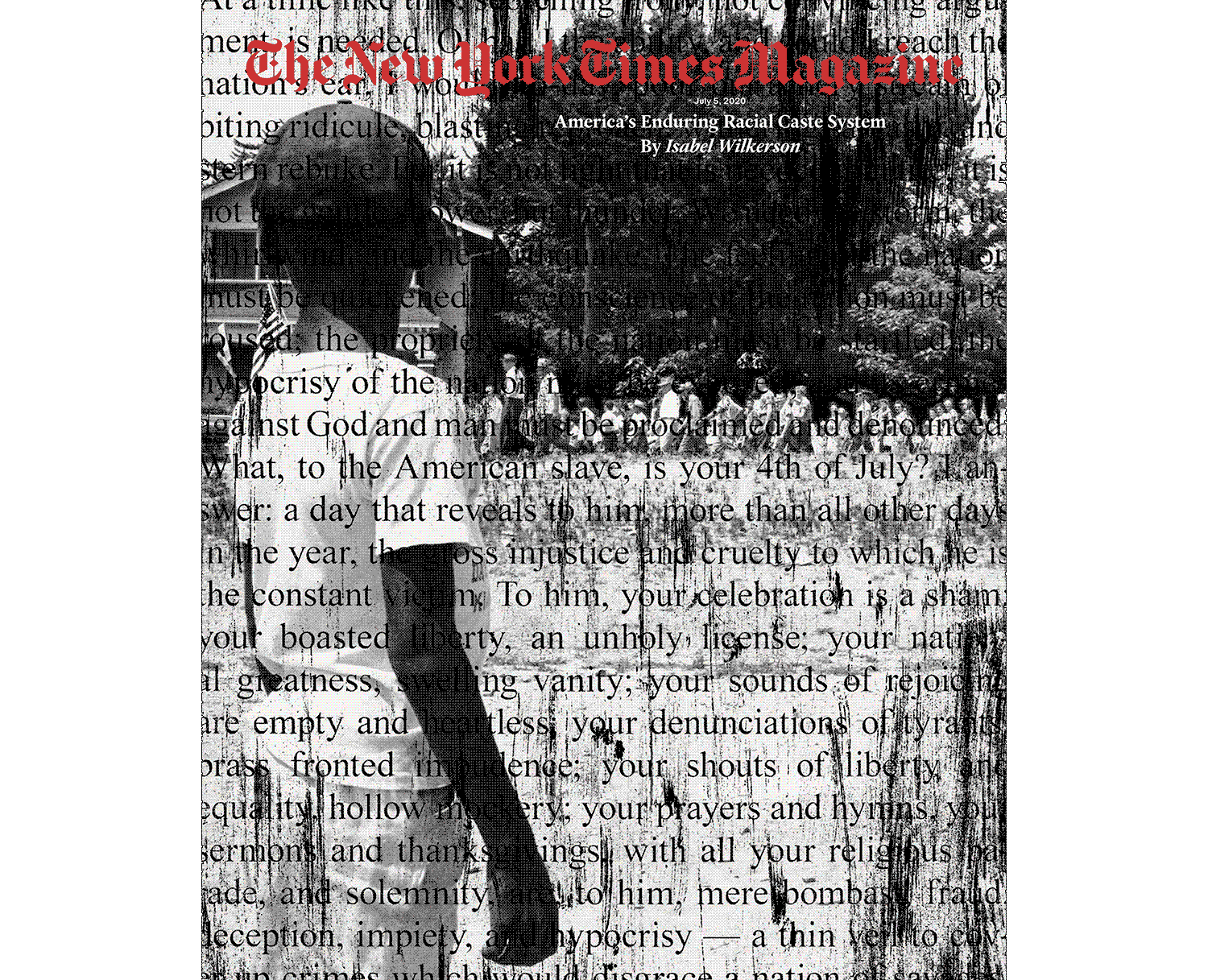
uses a 60-year old photograph of a young boy watching a group of people, some carrying American flags, march past to protest the admission of the “Little Rock Nine” to Central High School in Little Rock, Arkansas on August 20, 1959.

It‘s an extraordinarily powerful image. But then he’s layered the image, as he often does, with a text fragment. In this case it is an excerpt from an 1852 speech by Frederick Douglas, What to the American Slave is the Fourth of July. The image was cropped and both the photograph and the typeset text were then photocopied, or scanned, and otherwise marked by Adam. Productive noise was added and the recycled materials appear “handled” according to Times Magazine design director Gail Bichler.
The impossible collapse of times in the misregistered collage is typical of Adam's work and the reason why I wanted to introduce him in class. He takes existing materials, modifies them, and then puts them back in circulation where they carry both the original meaning as well as a time-shifted one.
I happend to see a show Adam made in New Orleans in 2016 called “Becoming Imperceptible.” It was at the Contemporary Arts Center. It was a great exhibition, but what I particularly remember is an all-over installation on the walls, and nooks and crannies, of the main floor of the museum. I’m sure I remember it in particular as I performed in front of it that night. (This is another story.) Anyway, it looked like this.

Looking at it now I am struck by the repeated Black Lives Matter text spray painted, repeated and fractured throughout. I suppose I am curious what the source is for this particular typography as when looking at a more recent project of Adam’s, Black Dada Flag (Black Lives Matter), I see the same typography recycled. The flag flew on the tip of Randall’s Island during the 2018 Frieze art fair in New York.
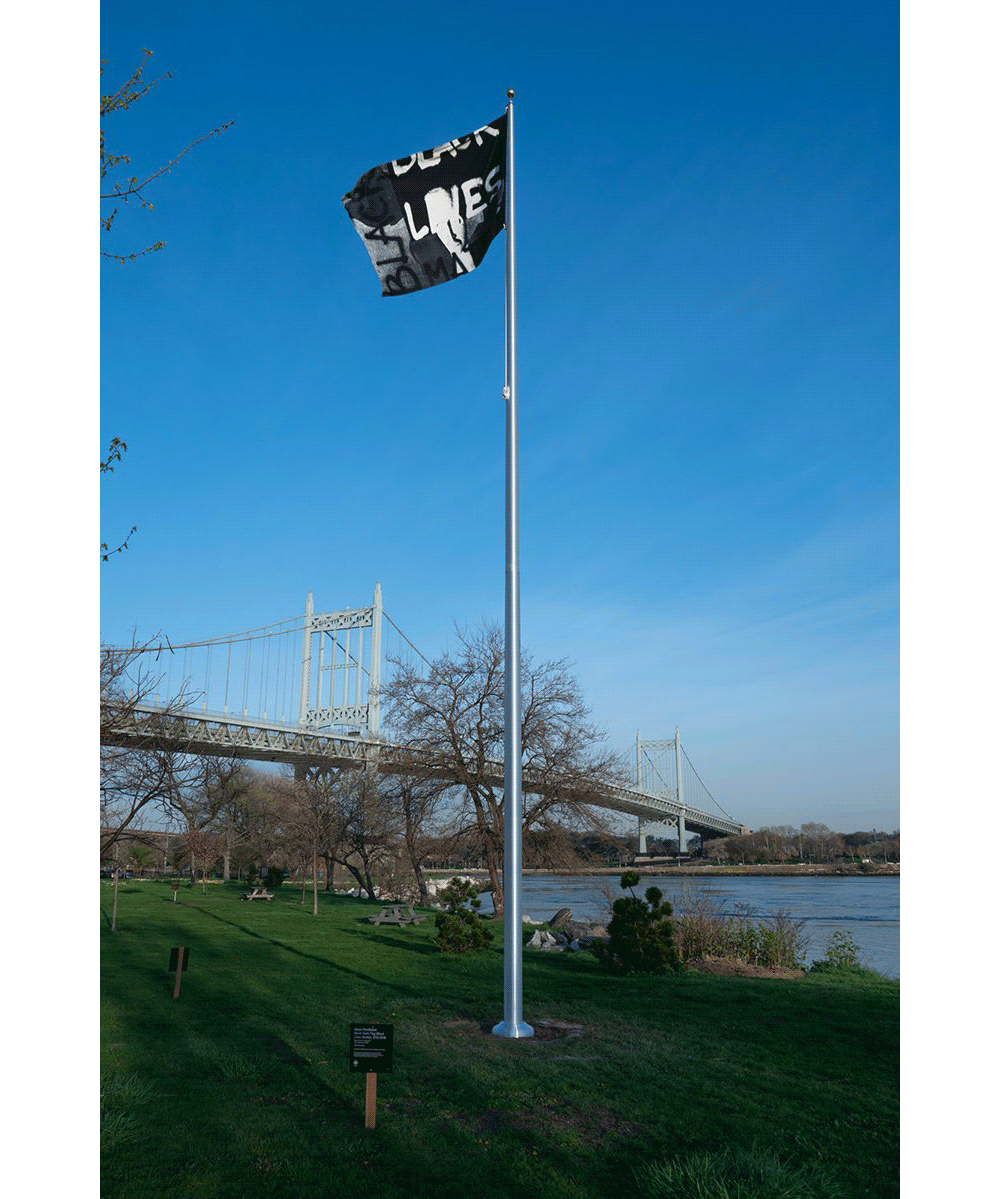
Anyway, it looks the same. Or similar enough to make me stop and think about how these graphics move around.
Continues in class . . .

uses a 60-year old photograph of a young boy watching a group of people, some carrying American flags, march past to protest the admission of the “Little Rock Nine” to Central High School in Little Rock, Arkansas on August 20, 1959.

It‘s an extraordinarily powerful image. But then he’s layered the image, as he often does, with a text fragment. In this case it is an excerpt from an 1852 speech by Frederick Douglas, What to the American Slave is the Fourth of July. The image was cropped and both the photograph and the typeset text were then photocopied, or scanned, and otherwise marked by Adam. Productive noise was added and the recycled materials appear “handled” according to Times Magazine design director Gail Bichler.
The impossible collapse of times in the misregistered collage is typical of Adam's work and the reason why I wanted to introduce him in class. He takes existing materials, modifies them, and then puts them back in circulation where they carry both the original meaning as well as a time-shifted one.
I happend to see a show Adam made in New Orleans in 2016 called “Becoming Imperceptible.” It was at the Contemporary Arts Center. It was a great exhibition, but what I particularly remember is an all-over installation on the walls, and nooks and crannies, of the main floor of the museum. I’m sure I remember it in particular as I performed in front of it that night. (This is another story.) Anyway, it looked like this.

Looking at it now I am struck by the repeated Black Lives Matter text spray painted, repeated and fractured throughout. I suppose I am curious what the source is for this particular typography as when looking at a more recent project of Adam’s, Black Dada Flag (Black Lives Matter), I see the same typography recycled. The flag flew on the tip of Randall’s Island during the 2018 Frieze art fair in New York.

Anyway, it looks the same. Or similar enough to make me stop and think about how these graphics move around.
Continues in class . . .
April 15, 2025
A Live Archive
Readings
The-Cobweb.pdf (Jill Lepore)
Resources
Black Lives Matter posters on The Internet Archive
The Wayback Machine
Just another WordPress Site
Assignment
#3 The Pioneer Plaque
Remember
Class meets today at StudioLab!
A Live Archive
Readings
The-Cobweb.pdf (Jill Lepore)
Resources
Black Lives Matter posters on The Internet Archive
The Wayback Machine
Just another WordPress Site
Assignment
#3 The Pioneer Plaque
Remember
Class meets today at StudioLab!
Brewster Kahle founded The Internet Archive in his San Francisco attic in 1996. By 2009, the project needed more space.
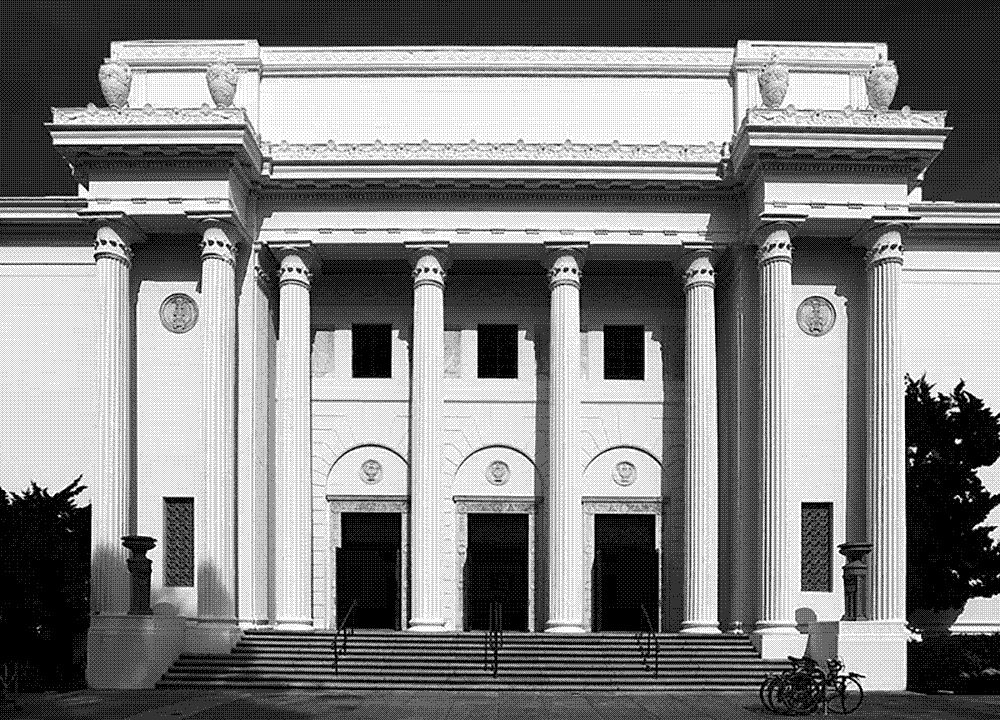
He tracked down a real estate listing on Funston Street in the outer Richmond and went to visit. The defunct Christian Science church made immediate sense. Kahle describes,
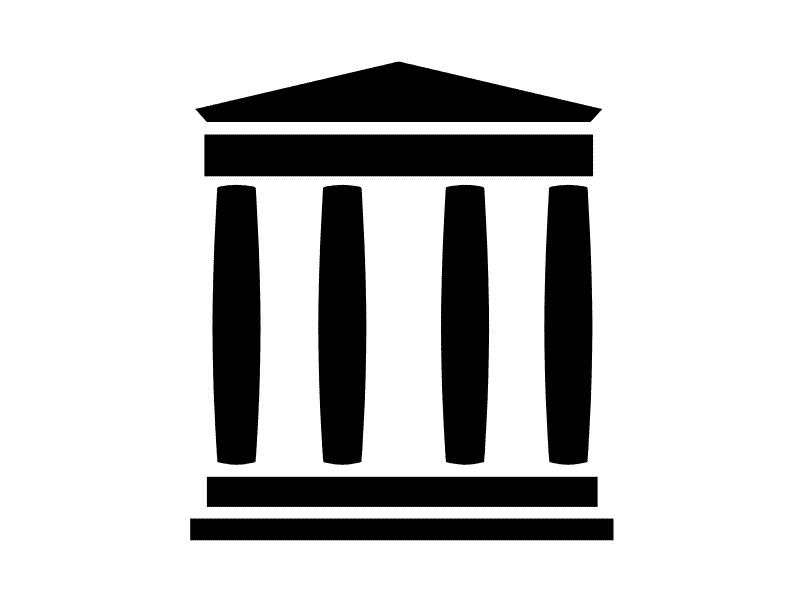
The Archive moved into a new home where it currently contains (at last count according to Wikipedia) over 20 million books, 3 million videos, 400,000 software programs, 7 million audio files, and 400 billion web pages. Webpages are collected and accessed through The Wayback Machine, which is a kind of Google-plus allowing a user to not only search a specific website *now* but also to access *previous* versions. It is an impossible and surely Sissyphian task, however The Internet Archive crawls the ever-changing world wide web making backups of the digital material it collects en route. Much of this data lives physically in the former church on custom-designed storage clusters called Petabox.
This all reminds me of the story about painting the Golden Gate Bridge (the entrance to which is not far from The Internet Archive). Because the Golden Gate has such intense fog and weather, repainting the bridge is a continuous task. When a painting crew has reached the far side, they start again moving in the opposite direction. Painting the Golden Gate its distinctive International Orange is a never-ending job.
This story sounds apocryphal, but a quick Google search confirms.

Anyway, what the Internet Archive does is, in fact, impossible. The internet is massive and constantly changing. Any attempt to collect a complete picture of it, like completely repainting the Golden Gate bridge, is not possible at any one time. However, a partial picture is still massively valuable. Brewster Kahle describes what he imagines like this:
Continues in class . . .

He tracked down a real estate listing on Funston Street in the outer Richmond and went to visit. The defunct Christian Science church made immediate sense. Kahle describes,
We bought this building because it matched our logo.

The Archive moved into a new home where it currently contains (at last count according to Wikipedia) over 20 million books, 3 million videos, 400,000 software programs, 7 million audio files, and 400 billion web pages. Webpages are collected and accessed through The Wayback Machine, which is a kind of Google-plus allowing a user to not only search a specific website *now* but also to access *previous* versions. It is an impossible and surely Sissyphian task, however The Internet Archive crawls the ever-changing world wide web making backups of the digital material it collects en route. Much of this data lives physically in the former church on custom-designed storage clusters called Petabox.
This all reminds me of the story about painting the Golden Gate Bridge (the entrance to which is not far from The Internet Archive). Because the Golden Gate has such intense fog and weather, repainting the bridge is a continuous task. When a painting crew has reached the far side, they start again moving in the opposite direction. Painting the Golden Gate its distinctive International Orange is a never-ending job.
This story sounds apocryphal, but a quick Google search confirms.

Anyway, what the Internet Archive does is, in fact, impossible. The internet is massive and constantly changing. Any attempt to collect a complete picture of it, like completely repainting the Golden Gate bridge, is not possible at any one time. However, a partial picture is still massively valuable. Brewster Kahle describes what he imagines like this:
The idea was to try to build the Library of Alexandria, version two.The Library of Alexandria was burned and much of the written material of the ancient Mediterranean world was lost forever. The Internet Archive was conceived to avoid this fate and has more than 40 petabytes of digital data stored across redundant data centers on what amounts to simply a lot of hard drives.
Continues in class . . .
Well, here is an image that’s on my desktop right now:
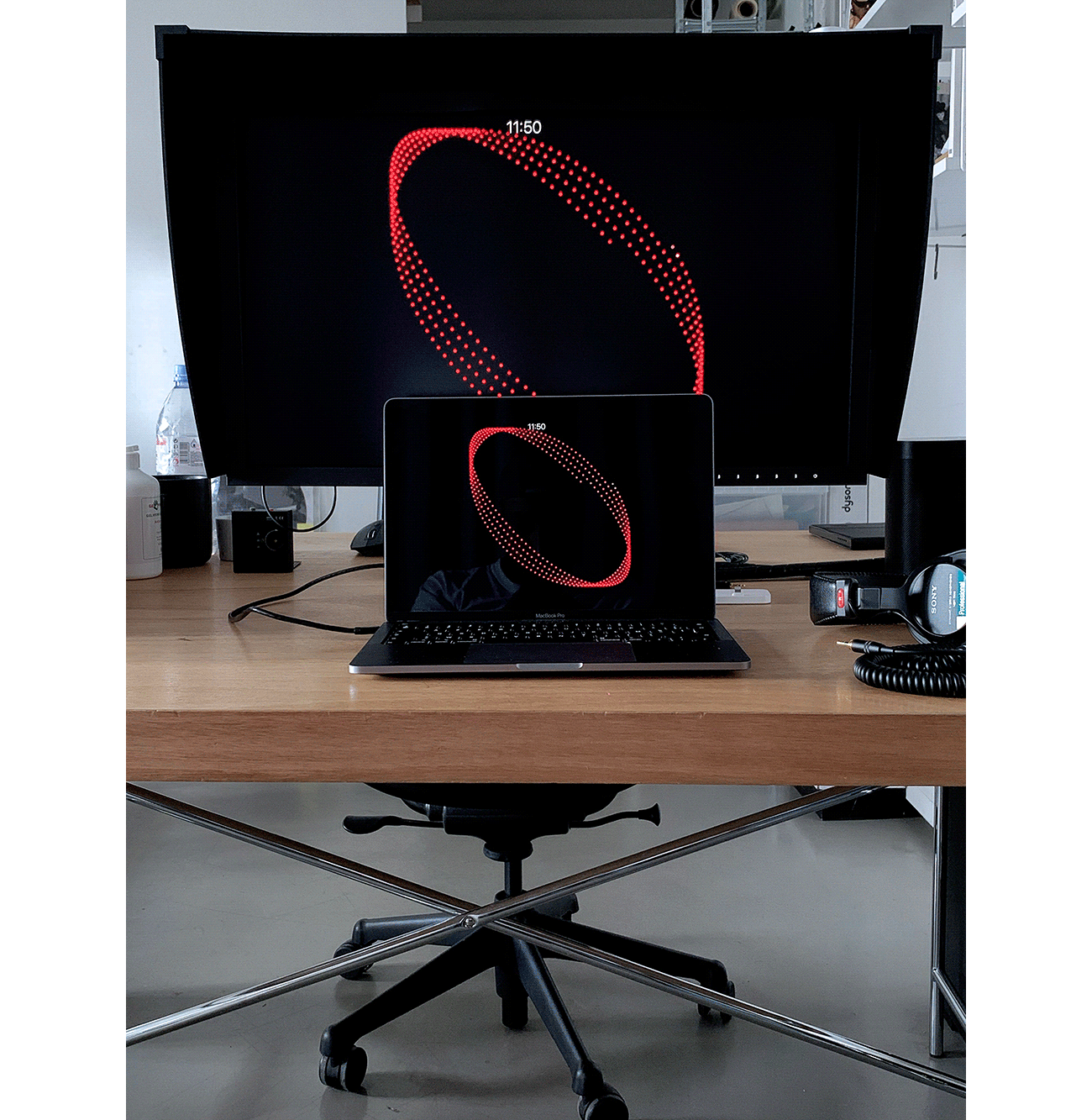
It is a picture of someone else's desktop. I like it very much. It was sent to me from Paris by someone I don’t know who installed a screen saver that I made on her computer. I had asked for
Today your final plaque and audience description is due. The audience description should be ~250 words and must be printed to turn in. Work not turned in then will be marked late. I look forward to seeing the finished plaques. Perhaps we can bolt them onto a rocket and send them out to the cosmos ... (Actually, we will hang them on the wall downstairs in the 185 Nassau basement.)
Continues in class . . .

It is a picture of someone else's desktop. I like it very much. It was sent to me from Paris by someone I don’t know who installed a screen saver that I made on her computer. I had asked for
an image of the software as installed wherever in the world it might find itself.I've been assembling a collection of similar images here. I find the collection mesmerizing. Here is, the same graphic, as found, in different places in the world. Each picture inevitably reveals some of the physical context. These remind me that when graphics circulate, they do not do so in a vacuum. The graphic always ends up somewhere, on a particular computer. We have tried to think about this over the course of the short semester, starting from Black Lives Matter and ending up in deep space.
Today your final plaque and audience description is due. The audience description should be ~250 words and must be printed to turn in. Work not turned in then will be marked late. I look forward to seeing the finished plaques. Perhaps we can bolt them onto a rocket and send them out to the cosmos ... (Actually, we will hang them on the wall downstairs in the 185 Nassau basement.)
Continues in class . . .